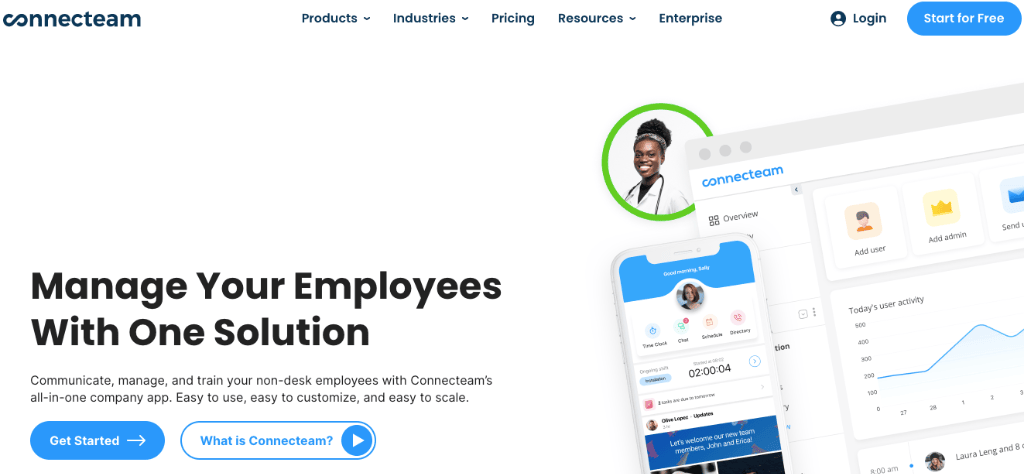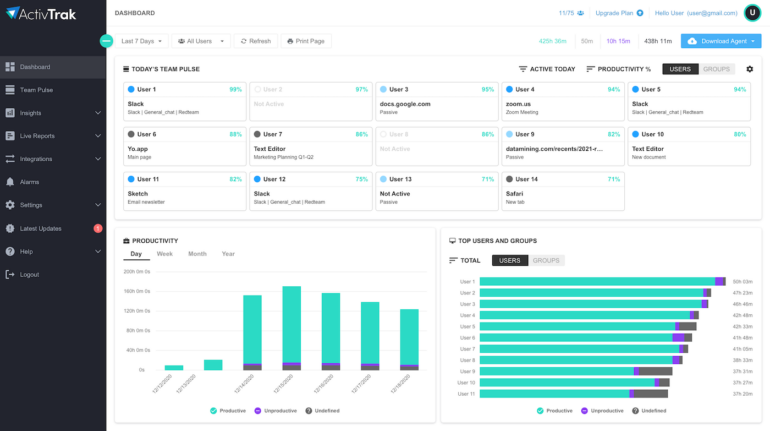Free Suggestions On Picking Employee Monitoring Software
What Is The Best Employee Monitoring Software? What Should I Know Before Choosing It?The term"employee-monitoring software" is used to describe an application that businesses use to monitor their employees' actions while they work. It allows employers gather data about various aspects of employee behaviors, including internet usage and application usage. Keystrokes are also tracked and screenshots can be taken. The main goal of software for monitoring employees is to increase productivity, ensure the compliance of policies, safeguard sensitive information, and address concerns regarding security. A variety of aspects should be taken into consideration when selecting an employee monitoring software. Be aware of these important aspects: Features- Decide which specific features you require in accordance with the needs of your organization. The most popular features are activity monitoring as well as blocking websites. Other options include keystroke logging as well as tracking software, email monitoring and report generation. Make sure you prioritize features that meet your monitoring objectives.
Privacy and Compliance: Make sure the software adheres to all legal and ethical guidelines for monitoring employees. Make sure you are aware of the laws and regulations applicable to your area. This includes data protection and privacy laws. Look for software that is clear and customizable privacy settings that are in line with employee rights.
User-Friendliness. Think about the user-friendliness and the accessibility of the software. It will save time and the process will be streamlined when you can use a simple interface and set-up process. Consider a dashboard that is customizable and intuitive reporting tools which allow you to quickly browse and analyze the collected data.
Integration and Compatibility: Verify the software's compatibility with your infrastructure. This includes operating systems, email software, project management platforms, and collaboration tools. Monitoring that is compatible ensures smooth operation without causing disruptions to day-today operations.
Data Security- Examine the security measures of the software to protect the data collected. Encryption, secure data storage access controls, as well as conformity with security protocols that are industry standard are vital. Verify the software's security practices.
Scalability: Think about how the software will scale to meet the needs of your growing company. If you're planning to expand your team or create new locations, you should choose a software that can easily be scaled to meet changing needs.
Analytics and Reporting: Check out the software’s reports and analytics features. You should look for options that provide a comprehensive view of employee productivity, timing allocation, and trends. Customizable reporting and analytics can assist you in making better decisions and pinpoint areas for improvement.
Customer Support- Evaluate the level of support offered by the software provider. Evaluate their responsiveness, availability and the quality of technical support. If you've got a competent customer service team they'll be able to offer quick assistance whenever problems arise.
Cost - Be aware of the pricing model like an annual fee, a subscription, or depending on usage. Know the pricing structure and any additional costs for support upgrades and other features. Budget your purchase in relation to the features and value provided.
Transparency and Communication with Employees Keep clear communication and openness when working with employees in relation to monitoring software. Explain the scope and purpose of the monitoring in a transparent manner. Be sure they know their rights to privacy and address any concerns.
By evaluating these factors it is possible to make an educated decision that is in line with your company's specific needs and respects employee privacy while meeting all lawful requirements. See the top rated employee monitoring services for website examples.

What Are The Features Of Employee Monitoring Software And How Can They Differ?
Software for employee monitoring offers a range of options to monitor and analyze the activities of employees. Some features are common to every employee monitoring software. It gives a complete overview of the time employees spend at work.
Keystroke Logging Keystroke logs record every keystroke made by employees. It helps identify productivity bottlenecks, detect unauthorised activities, and gather evidence for investigations should they be required.
Screenshots & Screen Recordings- Certain programs can take screen captures or record screens of employees on a regular basis. This is useful for monitoring employee performance, checking compliance or troubleshooting issues.
Internet Usage Tracking This function records employees' online activities, including the websites they visit, their search queries and downloads, among others. It can be used to detect excessive browsing that's not connected to work, possible security risks, or infractions.
Application Usage Tracking: This feature tracks which applications employees use during their working hours. It allows you to determine which apps are most popular and can help to identify inappropriate or illegal use of the application.
Email Monitoring - Email monitoring allows employers to monitor employee email messages, including those messages that were received and sent attachments, emails, and other emails' content. It helps to ensure conformity with corporate policies, to prevent leakage of data and look into any suspicious activity.
File and Document tracking- This feature tracks access to, modifications to, and transfers. It protects sensitive data, monitor document collaborative work, and ensure compliance to the security guidelines for data.
Remote Monitoring - Remote monitoring capabilities let employers track employees who work remotely or are in different locations. Employers can monitor employees' activities and ensure their efficiency, no matter the place they're located.
Productivity Analysis. Programs for monitoring employees usually include productivity analysis features that offer insight into employee patterns of work and productivity. These analyses identify areas in need of improvement and can help to optimize workflow.
Reporting & Analytics- Robust features for analytics and reporting create detailed reports using the data that is collected. These reports offer valuable insight about employee performance and the distribution of resources.
Compliance and Policy Management: Some software solutions come with features to ensure conformity with company policies and regulations. Employers can define and enforce company policies regarding acceptable use of computers.
Alerts & Notifications - Alerts and notifications alert employers and managers of certain events and activities. As an example they might alert employees users to avoid excessive use of the Internet, attempts at accessing restricted websites, and suspicious behaviors.
Be aware that these features are included in a variety of software options for monitoring employees. When choosing software, consider the features that are compatible with your monitoring goals and comply with legal and ethical guidelines in your region. Follow the most popular time tracking monitoring services for website advice.

How Can Employee Surveillance Software Comply With Compliance And Privacy Laws?
Employee monitoring software must be in compliance with laws regarding privacy and compliance. Here are some ways that employee monitoring software adheres with compliance and privacy laws regardless of the fact that the requirements for compliance vary between different jurisdictions. Consent and notice- A majority of jurisdictions require informed consent by employees, and require them to be notified of monitoring activities in advance. Monitoring tools for employees typically include options that permit employers to inform their employees in a concise way. This could be accomplished through the use of written notices sent to employees, getting their consent through consent forms, or by implementing a handbook outlining monitoring practices.
Transparent Monitoring Policies - Transparent monitoring policies encourage transparency by educating employees of what data is being collected, why they're being monitored, and how extensive the monitoring is. The clear and complete policies will help employees understand the boundaries of monitoring as well as their privacy rights.
Data minimization - In order to ensure compliance with privacy laws and employee monitoring software, a process of reduction is commonly used. Data minimization means that only vital information is collected, stored and avoided. This software can help reduce the risk of privacy breaches by only collecting information that is required to monitor.
Anonymization and Aggregation Some employee monitoring software anonymizes or aggregates data to further ensure protection of employee privacy. Anonymization removes personal identifiable information (PII) which makes it impossible for data to be linked with an individual. Aggregation involves the mixing of data from different employees to gain insight at a global scale.
Encryption and Secure Data storage Employee monitoring software puts the top priority on the security of data. Secure encryption and storage of data is used to safeguard information from unauthorized access or accidental disclosure. This includes securing data both during transit and in storage.
Access Controls and Restricted Permissions For compliance purposes, employee monitoring software typically offers granular access control and permissions. This allows employers limit access to the monitoring information to those who need it legally, such as HR personnel or administrators.
Employee Rights & Remedies The protection of the rights of employees is essential in ensuring compliance with privacy laws and compliance regulations. Most employee monitoring programs contain tools that allow employees to access their own personal information, make corrections or submit complaints. This lets employees decide to take action and exercise their rights if they feel that privacy has been infringed.
Conformity to Data Protection Regulations – The employee monitoring software was designed to conform with applicable data protection laws, such as General Data Protection Regulations in Europe and California Consumer Privacy Acts in the United States. Compliance involves implementing measures to protect personal data and respecting the rights of data subjects and ensuring the lawful processing of data.
Note that, while employee monitoring can help organizations comply with laws and regulations, they must also consult with lawyers and remain current with local laws and regulations. Compliance and privacy laws requires a comprehensive approach that goes far beyond the software itself, which includes clearly defined policies, training for employees and continuous monitoring of compliance. Take a look at the best employee monitoring software for site advice.
